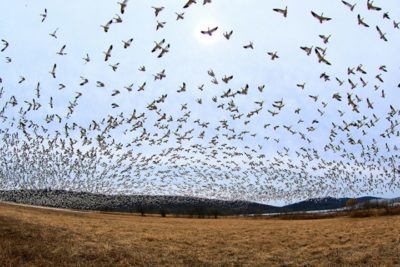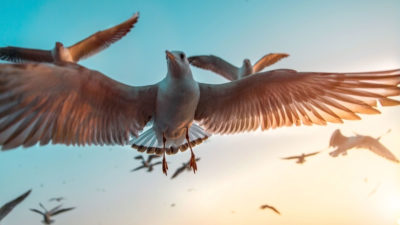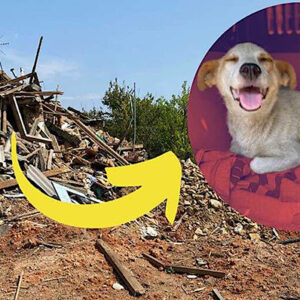
It is being discovered that massive numbers of birds are mysteriously dropping dead across the regions of New Mexico and Colorado. Wildlife researchers in the area are bewildered by the corpses of different migratory birds found by residents along hiking trails and other locations. The astounding number of avians dying reach hundreds of thousands…possibly millions.
Experts are unclear on the exact cause of the deaths, but some believe it is possibly connected to a recent cold front, ongoing droughts, and more likely, the tremendous amount of toxic smoke invading areas from the wildfires across the western states.
Professor Martha Desmond of New Mexico State University’s Department of Fish, Wildlife and Conservation Ecology told Las Cruces sun-News, “ It is terribly frightening. We’ve never seen anything like this…we’re losing probably hundreds of thousands, if not millions, of migratory birds.”
A team of wildlife experts at the Bureau of Land Management, NMSU, and White Sands Missile Range, are helping Prof. Desmond to establish the unexpected rise in bird deaths. The affected bird species’ include sparrows, warblers, blackbirds, swallows, flycatchers, and the western wood pewee.
“ A number of these birds are already in trouble. They are already experiencing huge population declines and then to have a traumatic event like this – it’s devastating,” explains Desmond.
A biologist at White Sands Missile Range, Trish Cutler, said, “ People have been reporting that the birds look sleepy…they’re just really lethargic.” she further adds, “ One thing we’re not seeing is our resident birds mixed in with these dead birds. We have resident birds that live here, some of them migrate and some of them don’t, but we’re not getting birds like roadrunners or quail or doves.”
Some believe the cold front that passed through the state may have contributed to the catastrophe. But Desmond explained that, “ what is odd is the fact that we’re seeing this occur beforehand and we’re seeing it occur since then.” However, the on-going dry spell may have played a role in the bird die-off, as well as the toxic smoke from the wildfires. Experts are not really sure what is generally responsible.
Desmond argues, “ it could be related to some of the drought conditions…It could also be related to the fires in the west.” she adds, “ There may have been some damage to these birds in their lungs [due to the fires].” Desmond continues, “ They may have been pushed out before they were ready to migrate,” she emphasized. “ They have to put on a certain amount of fat for them to be able to survive the migration. These birds migrate at night and they get up in the jet stream, and they might migrate for three nights in succession, they’ll come down and they’ll feed like crazy, put on more fat and go again.”
Last September 13, a video by journalist Austin Fisher while he was hiking in northern Rio Arriba County, showed large groups of dead birds along the trail. While he panned the camera to show the magnitude of the event, he can be heard saying, “ I have no idea.”
Reports of birds disappearing or turning up dead have surfaced as wildfires have ravaged multiple western states. But, much is still uncertain how wildfire smoke has impacted bird populations. “ Not much is known about the impacts of smoke and wildfires on birds,” wrote the Oregon Department of Fish and Wildlife on Twitter.

However, the Audubon Society notes that bird scientists and veterinarians are in agreement that smoke can leave a damaging impact on the lung tissue of captive birds, leaving them vulnerable to deadly respiratory infections.
Olivia Sanderfoot, a National Science Foundation Graduate Research Fellow, at the University of Washington in Seattle, who studies the impact of air pollution on birds, said, “ We do know that exposure to particulate matter, which of course is of great concern for human health, can affect birds as well.”
An article explained that bird populations in North America have significantly dropped by 29 percent, which is about 3 billion birds, since 1970. Similarly, a 2019 study explained that widespread high temperatures resulting from climate change are likely to tremendously change migration patterns of bird species. Nesting places have also diminished due to pastures and grasslands being converted to crops. And insects reduced by pesticides also contribute to altered migration patterns of birds.
Wildfire smoke is hazardous, no doubt. Luckily for humans, we can avoid the toxic smoke by staying indoors, or moving away to safer locations. Most creatures, including birds, are not as lucky. Hopefully the fires soon are extinguished…many species of animals would surely be very thankful.
What are your thoughts? Please comment below and share this news!
True Activist / Report a typo


